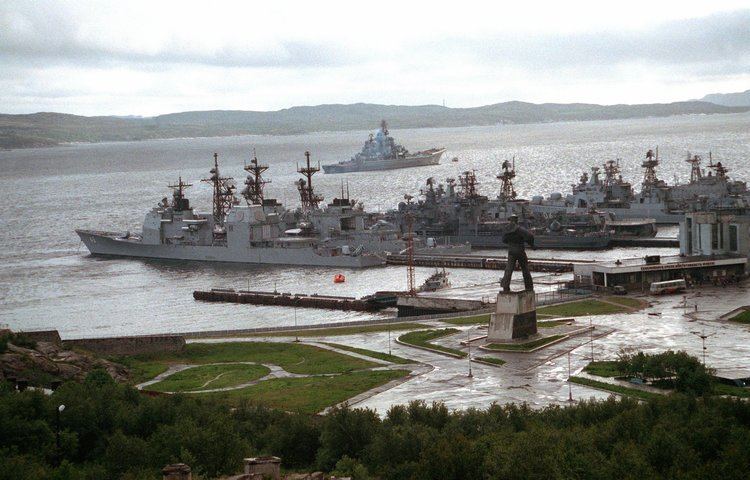Coat of arms Flag | Local time Thursday 8:07 PM | |
 | ||
Administrative center of closed administrative-territorial formation of Severomorsk Urban okrug Severomorsk Urban Okrug Weather -7°C, Wind W at 13 km/h, 65% Humidity | ||
Severomorsk (Russian: Северомо́рск), previously known as Vayenga (Ваенга), is a closed town in Murmansk Oblast, Russia. Severomorsk is the main administrative base of the Russian Northern Fleet. The town is located on the coast of the Barents Sea along the Kola Bay 25 kilometers (16 mi) northeast of Murmansk, the administrative center of the oblast, to which it is connected by railway and a motorway.
Contents
- Map of Severomorsk Murmansk Oblast Russia
- Early settlement
- The founding of the Northern Fleet Base
- Severomorsk
- Location
- Climate
- Population
- Landmarks
- Local government
- Administrative and municipal status
- Industry
- Military
- Famous people
- References
Map of Severomorsk, Murmansk Oblast, Russia
Early settlement
The first settlement on the site of the modern city arose between 1896 and 1897. It was named Vayenga (Ваенга), after the river, the name of which itself comes from the Sami "vayongg", meaning "doe" or "reindeer". In 1917, only thirteen people lived in the settlement, who engaged in hunting, fishing and animal husbandry.
The founding of the Northern Fleet Base
In 1926 the Murmansk office of logging was founded, one of the artels of which was sent to Vayenga. A barracks, a dormitory and a banya were built, and a telephone line was laid through the village. In 1933, the bay was chosen as one of the bases for the newly created Northern Fleet. From 1934 and until the beginning of World War II, wooden and brick buildings, as well as military installations, were built in the settlement, and a naval aviation airfield was built in the neighboring bay. From August 1941, all construction was suspended.
After the end of the war, construction was resumed. Vayenga, taking into account the existing arrangement, was chosen as one of the main bases of the Northern Fleet. On September 1, 1947, staff and management of the Northern Fleet were relocated from Polyarny to Vayenga. Also in 1947, the first secondary school in the city was opened. The population of Vayenga was then 3,884. In 1948, Vayenga's village Soviet of deputies of workers was opened.
Severomorsk
On April 18, 1951, Vayenga received town status and was renamed to Severomorsk, from the Russian "sever" (север), meaning "north", and "more" (море), meaning "sea". By the 1960s, the city was already thoroughly equipped. The city had its own bakery, sausage factory, and soft drink bottling plant, and a swimming pool was being built. On November 26, 1996, by the decree of the President of Russia, the city of Severomorsk, as a major naval base, was converted into a closed city. Settlements that have been merged into it include Safonovo, Roslyakovo, Safonovo-1, Severomorsk-3 and Shchukozero.
Location
Severomorsk is located on the Kola Peninsula in the Arctic Circle, in the permafrost zone, on the rocky east coast of the Kola Bay of the Barents Sea.
Climate
Severomorsk has a cold sea climate, with relatively mild winters and cool summers. The average temperature in January is -8 °C, and 12 °C in July. The average precipitation is around 800 mm per year.
Population
On January 1, 2015, out of 1114 Russian cities and towns, Severomorsk was ranked the 329th most populous.
According to the results of the Russian Census of 2010, the population of Severomorsk was 50,060. 26,503 (52.9%) of those were male, and 23,557 (47.1%) were female.
As of 2016, the population of Severomorsk has reached 50,905.
Landmarks
Local government
The representative bodies of the local self-government are the City Council of Deputies. The mayor of Severomorsk is Alexander Abramov.
Since 1991, the executive power has been headed by Vitaly Voloshin. In the spring of 2011, he was approved to the post of the Head of Administration of Severomorsk. Since April 16, 2013, the position is occupied by Irina Norina.
Administrative and municipal status
Within the framework of administrative divisions, it is, together with the urban-type settlement of Safonovo and two rural localities, incorporated as the closed administrative-territorial formation of Severomorsk—an administrative unit with the status equal to that of the districts. As a municipal division, the closed administrative-territorial formation of Severomorsk is incorporated as Severomorsk Urban Okrug.
Industry
Most of Severomorsk's industry is related to food, particularly the Severmorsk Dairy Plant, and the Toni Bottling Plant. There are also construction and shipyard companies, and a developed infrastructure of housing and communal and consumer services, as well as trade.
Military
The town is the main administrative base of the Russian Northern Fleet. Severomorsk has the largest dry dock on the Kola Peninsula.
On May 13, 1984, on the outskirts of Severomorsk, there was a major fire at a stockpile of naval missiles that resulted in numerous large explosions on May 17. The incident killed 200–300 people, and destroyed at least one third of the Northern Fleet's stockpile of surface-to-air missiles.
